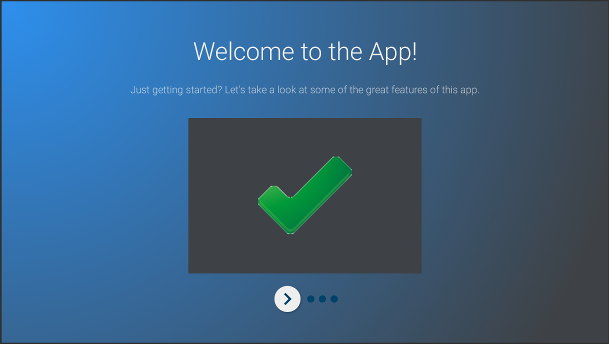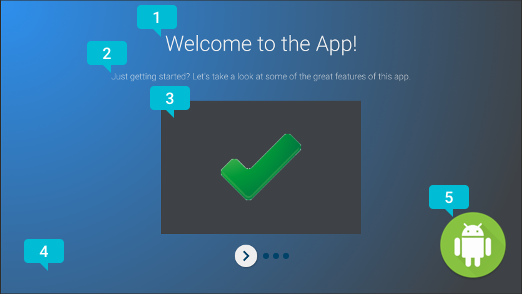Pour montrer aux nouveaux utilisateurs comment exploiter pleinement votre application, présentez les informations d'intégration au démarrage de l'application. Voici quelques exemples d'informations sur l'intégration:
- Présenter des informations détaillées sur les canaux disponibles lorsqu'un utilisateur accède pour la première fois à une application de canal
- Attirez l'attention sur les fonctionnalités intéressantes de votre application.
- Illustrez les étapes obligatoires ou recommandées que les utilisateurs doivent suivre lorsqu'ils utilisent l'application pour la première fois.
La bibliothèque Android Leanback fournit la classe OnboardingSupportFragment pour présenter des informations utilisateur inédites. Ce guide explique comment utiliser la classe OnboardingSupportFragment pour présenter les informations de présentation qui s'affichent lors du premier lancement de l'application.
OnboardingSupportFragment utilise les bonnes pratiques d'UI du téléviseur pour présenter les informations d'une manière qui correspond aux styles d'UI du téléviseur et facilite la navigation sur les téléviseurs.

Figure 1 : Un exemple OnboardingSupportFragment.
OnboardingSupportFragment ne convient pas à tous les cas d'utilisation.
N'utilisez pas OnboardingSupportFragment lorsque vous devez inclure des éléments d'interface utilisateur qui nécessitent une entrée utilisateur, tels que des boutons et des champs.
N'utilisez pas non plus OnboardingSupportFragment pour les tâches que l'utilisateur effectuera régulièrement. Enfin, si vous devez présenter une UI de plusieurs pages nécessitant une entrée utilisateur, envisagez d'utiliser un GuidedStepSupportFragment.
Ajouter un OnboardingSupportFragment
Pour ajouter un OnboardingSupportFragment à votre application, implémentez une classe qui étend la classe OnboardingSupportFragment. Ajoutez ce fragment à une activité, à l'aide du code XML de mise en page de l'activité ou par programmation. Assurez-vous que l'activité ou le fragment utilise un thème dérivé de Theme_Leanback_Onboarding, comme décrit dans la section Personnaliser les thèmes.
Dans la méthode onCreate() de l'activité principale de votre application, appelez startActivity() avec un Intent qui pointe vers l'activité parente de votre OnboardingSupportFragment.
Cela permet de garantir que votre OnboardingSupportFragment s'affiche dès le démarrage de votre application.
Pour vous assurer que l'OnboardingSupportFragment n'apparaît que la première fois que l'utilisateur démarre votre application, utilisez un objet SharedPreferences afin de savoir si l'utilisateur a déjà consulté l'OnboardingSupportFragment. Définissez une valeur booléenne qui devient "true" lorsque l'utilisateur a fini d'afficher l'élément OnboardingSupportFragment. Vérifiez cette valeur dans la méthode onCreate() de votre activité principale et ne démarrez l'activité parente OnboardingSupportFragment que si la valeur est "false".
L'exemple suivant montre un forçage de onCreate() qui recherche une valeur SharedPreferences et, s'il n'est pas défini sur "true", appelle startActivity() pour afficher OnboardingSupportFragment:
Kotlin
override fun onCreate(savedInstanceState: Bundle?) {
super.onCreate(savedInstanceState)
setContentView(R.layout.activity_main)
PreferenceManager.getDefaultSharedPreferences(this).apply {
// Check if we need to display our OnboardingSupportFragment
if (!getBoolean(MyOnboardingSupportFragment.COMPLETED_ONBOARDING_PREF_NAME, false)) {
// The user hasn't seen the OnboardingSupportFragment yet, so show it
startActivity(Intent(this@OnboardingActivity, OnboardingActivity::class.java))
}
}
}
Java
@Override
protected void onCreate(Bundle savedInstanceState) {
super.onCreate(savedInstanceState);
setContentView(R.layout.activity_main);
SharedPreferences sharedPreferences =
PreferenceManager.getDefaultSharedPreferences(this);
// Check if we need to display our OnboardingSupportFragment
if (!sharedPreferences.getBoolean(
MyOnboardingSupportFragment.COMPLETED_ONBOARDING_PREF_NAME, false)) {
// The user hasn't seen the OnboardingSupportFragment yet, so show it
startActivity(new Intent(this, OnboardingActivity.class));
}
}
Une fois que l'utilisateur a vu la OnboardingSupportFragment, marquez-la comme telle à l'aide de l'objet SharedPreferences. Pour ce faire, remplacez onFinishFragment() dans OnboardingSupportFragment et définissez la valeur SharedPreferences sur "true", comme illustré dans l'exemple suivant:
Kotlin
override fun onFinishFragment() {
super.onFinishFragment()
// User has seen OnboardingSupportFragment, so mark our SharedPreferences
// flag as completed so that we don't show our OnboardingSupportFragment
// the next time the user launches the app
PreferenceManager.getDefaultSharedPreferences(context).edit().apply {
putBoolean(COMPLETED_ONBOARDING_PREF_NAME, true)
apply()
}
}
Java
@Override
protected void onFinishFragment() {
super.onFinishFragment();
// User has seen OnboardingSupportFragment, so mark our SharedPreferences
// flag as completed so that we don't show our OnboardingSupportFragment
// the next time the user launches the app
SharedPreferences.Editor sharedPreferencesEditor =
PreferenceManager.getDefaultSharedPreferences(getContext()).edit();
sharedPreferencesEditor.putBoolean(
COMPLETED_ONBOARDING_PREF_NAME, true);
sharedPreferencesEditor.apply();
}
Ajouter des pages OnboardingSupportFragment
Un OnboardingSupportFragment affiche le contenu sous la forme d'une série de pages ordonnées. Après avoir ajouté votre OnboardingSupportFragment, vous devez définir les pages d'intégration. Chaque page peut comporter un titre, une description et plusieurs sous-vues pouvant contenir des images ou des animations.

Figure 2. OnboardingSupportFragment.
La figure 2 montre un exemple de page avec des accroches marquant des éléments de page personnalisables que votre OnboardingSupportFragment peut fournir. Les éléments de la page sont les suivants:
- Titre de la page.
- Description de la page.
- Affichage du contenu de la page, dans ce cas une simple coche verte dans une case grise Cette vue est facultative. Utilisez cette vue pour illustrer les détails de la page. Par exemple, vous pouvez inclure une capture d'écran qui met en évidence la fonctionnalité de l'application décrite sur la page.
- Vue en arrière-plan de la page, dans ce cas un simple dégradé bleu. Cette vue s'affiche toujours derrière les autres vues de la page. Cette vue est facultative.
- Vue au premier plan de la page, dans ce cas un logo. Cette vue s'affiche toujours devant toutes les autres vues de la page. Cette vue est facultative.
Initialisez les informations de page lorsque votre OnboardingSupportFragment est créé pour la première fois ou associé à l'activité parent, car le système demande des informations sur la page lorsqu'il crée la vue du fragment. Vous pouvez initialiser les informations de la page dans votre constructeur de classe ou dans un remplacement de onAttach().
Remplacez chacune des méthodes suivantes, qui fournissent des informations sur la page au système:
getPageCount()renvoie le nombre de pages dans votreOnboardingSupportFragment.getPageTitle()renvoie le titre du numéro de page demandé.getPageDescription()renvoie la description du numéro de page demandé.
Remplacez chacune des méthodes suivantes pour fournir des sous-vues facultatives afin d'afficher des images ou des animations:
onCreateBackgroundView()renvoie unViewque vous avez créé pour servir de vue d'arrière-plan ou une valeur nulle si aucune vue d'arrière-plan n'est nécessaire.onCreateContentView()renvoie unViewque vous avez créé pour agir en tant que vue de contenu ou une valeur nulle si aucune vue de contenu n'est nécessaire.onCreateForegroundView()renvoie unViewque vous avez créé pour agir en tant que vue de premier plan, ou une valeur nulle si aucune vue de premier plan n'est nécessaire.
Le système ajoute le View que vous créez à la mise en page. L'exemple suivant remplace onCreateContentView() et renvoie un ImageView:
Kotlin
private lateinit var contentView: ImageView
...
override fun onCreateContentView(inflater: LayoutInflater?, container: ViewGroup?): View? {
return ImageView(context).apply {
scaleType = ImageView.ScaleType.CENTER_INSIDE
setImageResource(R.drawable.onboarding_content_view)
setPadding(0, 32, 0, 32)
contentView = this
}
}
Java
private ImageView contentView;
...
@Override
protected View onCreateContentView(LayoutInflater inflater, ViewGroup container) {
contentView = new ImageView(getContext());
contentView.setScaleType(ImageView.ScaleType.CENTER_INSIDE);
contentView.setImageResource(R.drawable.onboarding_content_view);
contentView.setPadding(0, 32, 0, 32);
return contentView;
}
Ajouter un écran de logo initial
Votre OnboardingSupportFragment peut commencer par un écran de logo facultatif qui présente votre application. Si vous souhaitez afficher un Drawable comme écran de logo, appelez setLogoResourceId() avec l'ID de votre Drawable dans la méthode onCreate() de votre OnboardingSupportFragment.
Le système apparaît en fondu et affiche brièvement le Drawable, puis disparaît en fondu du Drawable avant d'afficher la première page de votre OnboardingSupportFragment.
Si vous souhaitez fournir une animation personnalisée pour votre écran de logo, au lieu d'appeler setLogoResourceId(), remplacez onCreateLogoAnimation() et renvoyez un objet Animator qui affiche votre animation personnalisée, comme illustré dans l'exemple suivant:
Kotlin
public override fun onCreateLogoAnimation(): Animator =
AnimatorInflater.loadAnimator(context, R.animator.onboarding_logo_screen_animation)
Java
@Override
public Animator onCreateLogoAnimation() {
return AnimatorInflater.loadAnimator(getContext(),
R.animator.onboarding_logo_screen_animation);
}
Personnaliser les animations de page
Le système utilise des animations par défaut lors de l'affichage de la première page de votre OnboardingSupportFragment et lorsque l'utilisateur accède à une autre page. Vous pouvez personnaliser ces animations en ignorant les méthodes dans votre OnboardingSupportFragment.
Pour personnaliser l'animation qui apparaît sur votre première page, remplacez onCreateEnterAnimation() et renvoyez un Animator.
L'exemple suivant crée un Animator qui redimensionne la vue de contenu horizontalement:
Kotlin
override fun onCreateEnterAnimation(): Animator =
ObjectAnimator.ofFloat(contentView, View.SCALE_X, 0.2f, 1.0f)
.setDuration(ANIMATION_DURATION)
Java
@Override
protected Animator onCreateEnterAnimation() {
Animator startAnimator = ObjectAnimator.ofFloat(contentView,
View.SCALE_X, 0.2f, 1.0f).setDuration(ANIMATION_DURATION);
return startAnimator;
}
Pour personnaliser l'animation utilisée lorsque l'utilisateur accède à une autre page, remplacez onPageChanged().
Dans votre méthode onPageChanged(), créez des objets Animator qui suppriment la page précédente et affichent la page suivante, ajoutez-les à un AnimatorSet et lancez la lecture de l'ensemble. L'exemple suivant utilise une animation de fondu pour supprimer la page précédente, met à jour l'image de la vue du contenu et utilise une animation de fondu pour afficher la page suivante:
Kotlin
override fun onPageChanged(newPage: Int, previousPage: Int) {
// Create a fade-out animation for previousPage and, once
// done, swap the contentView image with the next page's image
val fadeOut = ObjectAnimator.ofFloat(mContentView, View.ALPHA, 1.0f, 0.0f)
.setDuration(ANIMATION_DURATION)
.apply {
addListener(object : AnimatorListenerAdapter() {
override fun onAnimationEnd(animation: Animator) {
mContentView.setImageResource(pageImages[newPage])
}
})
}
// Create a fade-in animation for nextPage
val fadeIn = ObjectAnimator.ofFloat(mContentView, View.ALPHA, 0.0f, 1.0f)
.setDuration(ANIMATION_DURATION)
// Create AnimatorSet with fade-out and fade-in animators and start it
AnimatorSet().apply {
playSequentially(fadeOut, fadeIn)
start()
}
}
Java
@Override
protected void onPageChanged(final int newPage, int previousPage) {
// Create a fade-out animation for previousPage and, once
// done, swap the contentView image with the next page's image
Animator fadeOut = ObjectAnimator.ofFloat(mContentView,
View.ALPHA, 1.0f, 0.0f).setDuration(ANIMATION_DURATION);
fadeOut.addListener(new AnimatorListenerAdapter() {
@Override
public void onAnimationEnd(Animator animation) {
mContentView.setImageResource(pageImages[newPage]);
}
});
// Create a fade-in animation for nextPage
Animator fadeIn = ObjectAnimator.ofFloat(mContentView,
View.ALPHA, 0.0f, 1.0f).setDuration(ANIMATION_DURATION);
// Create AnimatorSet with fade-out and fade-in animators and start it
AnimatorSet set = new AnimatorSet();
set.playSequentially(fadeOut, fadeIn);
set.start();
}
Pour en savoir plus sur la création d'objets Animator et AnimatorSet, consultez la section
Présentation de l'animation des propriétés.
Personnaliser les thèmes
Toute implémentation de OnboardingSupportFragment doit utiliser le thème Theme_Leanback_Onboarding ou un thème qui hérite de Theme_Leanback_Onboarding. Définissez le thème de votre OnboardingSupportFragment en effectuant l'une des opérations suivantes:
- Définissez l'activité parente de
OnboardingSupportFragmentpour utiliser le thème souhaité. L'exemple suivant montre comment définir une activité pour utiliserTheme_Leanback_Onboardingdans le fichier manifeste de l'application :<activity android:name=".OnboardingActivity" android:enabled="true" android:exported="true" android:theme="@style/Theme.Leanback.Onboarding"> </activity>
-
Définissez le thème dans l'activité parent à l'aide de l'attribut
LeanbackOnboardingTheme_onboardingThemedans un thème d'activité personnalisé. Faites pointer cet attribut vers un autre thème personnalisé utilisé uniquement par les objetsOnboardingSupportFragmentde votre activité. Utilisez cette approche si votre activité utilise déjà un thème personnalisé et que vous ne souhaitez pas appliquer de stylesOnboardingSupportFragmentà d'autres vues de l'activité. - Remplacez
onProvideTheme()et renvoyez le thème souhaité. Utilisez cette approche si plusieurs activités utilisent votreOnboardingSupportFragmentou si l'activité parent ne peut pas utiliser le thème souhaité. L'exemple suivant remplaceonProvideTheme()et renvoieTheme_Leanback_Onboarding:Kotlin
override fun onProvideTheme(): Int = R.style.Theme_Leanback_Onboarding
Java
@Override public int onProvideTheme() { return R.style.Theme_Leanback_Onboarding; }

